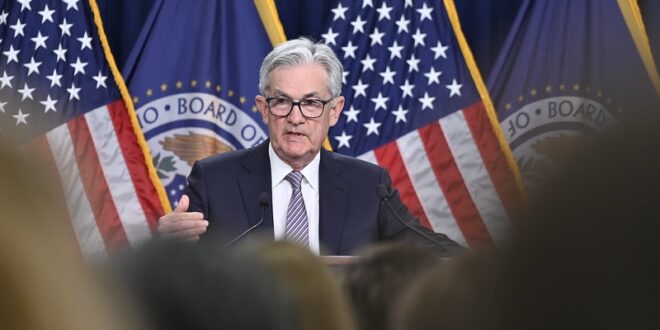On July 26, the Federal Open Market Committee (FOMC) announced its decision to raise the target range for the federal funds rate to 5.25% to 5.50%, reaching the highest level in twenty-two years.
This rate hike comes after the Federal Reserve paused its rate increases in June and represents a resumption of the gradual pace of rate hikes. The Fed’s decision was in line with market expectations. However, there are differing views between the Fed and the market regarding the future outlook for rate hikes. The Fed leans towards another rate hike in September, while many market institutions have different opinions on it. Tools from the Chicago Mercantile Exchange (CME) indicated that the futures market predicted a probability of around 99% for a 25-basis point rate hike announcement by the Fed in July, but the combined probability of at least one more 25-basis point rate hike from July to the end of this year was less than 37%.
Despite market optimism, the Fed remains concerned about the persistence of inflation. Thus, the main difference between the Fed and the market still lies in their views on the future direction of the U.S. economy and inflation trends.
However, there is a general consensus that the Fed’s current rate hike cycle is nearing its end. Whether there will be another rate hike this year is not of great importance. Fed chair Jerome Powell stated after the rate hike that there is a strong rationale for slowing down the pace of rate increases and that the Fed will continue to rely on data to guide future rate hikes, in which the decision for the September meeting will depend on further data. If the data supports it, there might be a rate hike in September, but it is also possible that the hikes will not take place. This means that there is not a significant difference between the Fed and market institutions regarding the issue of interest rate peaks, as both will rely on inflation and employment data to make new decisions. As for market expectations of rate cuts later this year, Powell emphasized that there will not be any rate cuts this year, and whether or not there will be rate cuts will depend on the Fed’s confidence in inflation reaching its target. However, some FOMC members expect rate cuts next year.
Recently, the market has become optimistic due to the decline in inflation levels. In June, the Consumer Price Index (CPI) rose by 3% year-on-year, compared to a 9.1% increase the previous year. However, the CPI excluding food and energy remained at 4.8%. According to the Cleveland Federal Reserve Bank’s CPI tracking data, the overall annualized inflation rate in July was 3.4%, with core inflation at 4.9%. The Personal Consumption Expenditures Price Index, favored by the Fed, rose by 3.8% overall and 4.6% for core in May. Keeping inflation levels at the 2% target is one of the Fed’s responsibilities. Despite the strong performance of the U.S. economy, the concern lies in the persistence of optimistic data on employment levels, indicating that inflation is becoming a long-term issue closely tied to economic growth. This suggests that the U.S. economy is likely to follow the path of parallel decline in inflation and economic growth as previously predicted by researchers at ANBOUND.
The Fed remains optimistic about achieving a soft landing and believes that the U.S. economy will avoid a recession. However, in the eyes of the market, the Fed is at risk of repeating the mistake of raising rates too late and missing the optimal time for rate cuts. As the turning point approaches, the potential losses from such policy risks will be greater. After the rate hike in July, the target range for the federal funds rate reached 5.25%-5.5%, the highest level since 2001. Whether there will be another rate hike in September or not, the U.S. interest rates are already relatively high, which will likely restrain inflation and employment. The longer the Fed maintains high interest rates, the greater the negative impact on the economy. Achieving a soft landing and navigating policy transitions pose significant challenges for the it. In fact, central banks of various countries nearing the end of the tightening cycle are all facing similar issues. Recently, an advisor to the UK Treasury warned that the Bank of England’s excessive rate hikes could lead the economy into a recession. Therefore, market concerns deserve serious consideration. If inflation persists stubbornly, the Fed may find itself compelled to sustain higher interest rates for an extended period, which could potentially lead to an economic downturn.
According to researchers at ANBOUND, the Fed reaching the peak of interest rate hikes may not necessarily mean the resolution of risk factors or the establishment of economic growth prospects. Under high-interest rate conditions, the pressure on the U.S. capital market and employment demand may be greater. This could be one reason why capital market investors are eager for it to cut interest rates. However, this also implies that the Fed will face more severe policy risks.
Final analysis conclusion:
As anticipated by the market, the Federal Reserve recently announced a 25-basis point interest rate hike. While many, including the Fed itself, believe that the rate hikes are nearing a turning point, the end of the monetary policy cycle may introduce additional risks. On one hand, market demand could contract under pressure, and on the other hand, the risk of policy exit is rising. Hence, the “war” between the Fed and inflation is far from being concluded.
 Eurasia Press & News
Eurasia Press & News



